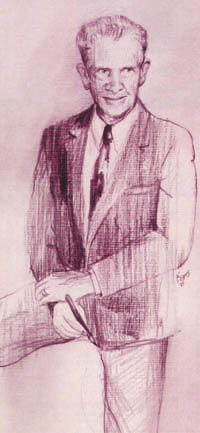|
|
| Masterful Matthews by William Stage from Signs of the Times magazine; July, 1985 issue, pp 58-59, 154-156
The late signpainter's career is over, but his devotion to his trade is preserved in his many instructional books. He was an author, artist, cowboy and signpainter. He was a teacher whose willingness to share his knowledge of sign crafting was virtually unlimited. Eric C. Matthews, better known as E.C., was a doer who, gone now a decade, takes a place among the master signpainters. Like the Western artist Charlie Russell, Matthews left home at a young age, hoping to join a rodeo or become an artist. He would get his chance at both.
|
 |
"When Matthews was 18 in 1911, he entered the bronco riding contest in the rodeo in Cheyenne, WY," a yellowed edition of the Colorado Spring Gazette Telegraph reports. "His mother was worried about him so he wrote her a letter which read: 'I rode today and am getting along fine.' He failed to mention that he didn't win."
Matthews ended up in Colorado Springs, where he served apprenticeships under three signmen, each of whom had adjunct specialties: One was a landscape painter; another was an old "wall dog" who scorned soft brushes and lettered everything with his fitches, and another specialized in cards and banners and had the first airbrush in that part of the country. From them, Matthews received as broad a base of practical experience as could be had.
In May, 1912, he lettered his first "trucks," two big horse-drawn wagons for Wandell and Lowe Transfer Co. Horseless trucks were still scarce, and the few who did own them weren't about to desecrate them with advertising. It was a good initiation to the trade, for truck, "sho' card" and sign lettering would be his mainstay for the next half century.
No matter how quickly and roughly he lettered, Matthews' signs always had a certain flair. In fact, he preferred a quickly lettered script whenever it would fit in. He said it broke up the stiffness which characterized some signwork.
Somewhere out West, Matthews hooked up with Ivan Stroh of St. Louis. Stroh was a strongman and a boxer with a traveling circus. Matthews like him and decided to make a signpainter out of him. For years they worked the country, putting up in Cincinnati, Toledo, Denver, Kansas City and other cities. Sure, they painted signs and learned plenty in the bargain. But, by all accounts, they were raising just a little hell and having the time of their lives.
Lonnie Tettaton, a leading St. Louis signman who worked with both after they eventually settled there, describes Ivan Stroh as a "short, muscular rough-cut man, full of vinegar." By contrast, he recalls Matthews as "strong, but soft-spoken with a mild Western accent." Specifically, E.C. was tall and slender--"gawky" he once said--with a wavy shock of dark hair. He wore plain wire-rimmed spectacles. He smoked cigars and, when the butt became soggy, he would snip the end with a pair of scissors.
The first Letterheads
Writing in the March 1962 issue of Signs of the Times (
He's Been Lettering Trucks for 50 Years ), J. David Paisley reports
that Matthews moved to St. Louis in 1916 and was immediately attracted
to the beautiful goldleaf window signs of Gus Fennerty. When Matthews
visited the Fennerty studio, he learned the virtuoso work was done by
Alf Becker, who as a boy had followed Denver sign artist John Ohnimus
around as he painted signs for the 1904 St. Louis World's Fair. A friendship
developed between Matthews and Becker which lasted over 40 years.
Matthews still wanted to be an artist, so he enrolled in the Lockwood School of Art in Kalamazoo, MI. Apparently, he could not resist the lure of signpainting, because in the spring of 1920, Matthews took a job lettering trucks with a large auto painting company in New York. He earned about $10 a day. In those days, trucks were lettered in gold or aluminum leaf and were often accented with elaborate scrolls. Such lettering was charged for by the foot, and it was the custom of the shop to use an extended style of lettering.
Matthews claimed he usually worked one to three days on each truck. Twenty years later, during World War II, there were so many trucks to letter that he devised over 20 stock pounce patterns, consisting of guidelines only, which would fit almost any wording on doors and panels. This saved time otherwise spent in measuring and snapping lines. By this method, Matthews claimed he was able to letter as many as six small trucks a day, all with different layouts and lettering. As both signpainter and instructor, Matthews took it upon himself to know every new development in his field. "There have been many changes since I started in the work," he once wrote, "and I promised myself as a young man I would keep up with the times and change my thinking and my techniques as often as might be necessary."
For many years, Matthews traveled extensively around the country, apparently using St. Louis and Denver as bases to which he would periodically return. His significance to the sign and lettering profession is that he observed and linked together various lettering styles, tricks of the trade and sundry bits of knowledge which he wove into the contents of numerous books and pamphlets on signpainting (Bibliography).
His first book, How to Paint Signs and Sho' Cards, was published in New York in 1920. It went through many editions and was on the market until 1940. In 1928, Matthews revised the Sign and Show Card Course for the Detroit School of Lettering, furnishing many new illustrations. His opus magnus however, was The Sign Painting Course, an impressive compendium of sign crafting published by the Nelson-Hall Co. in 1960. These volumes helped start countless sign makers on their way to commercial success.
Remarked Paisley, "He was always ready to help the beginner and not one to keep a good idea secret."
And he had plenty of good ideas. Prior to the First World War, for example, many old-timers considered it verboten to trim window lettering with a razor blade; everything had to be done with a brush. Matthews demonstrated the easier method on goldleaf and other glass signs wherever he worked, and others soon followed suit.
Matthews also pioneered the Lacquer System, an improved method of inside window lettering. Instead of using varnish or Fibroseal to mix gold, bronze or aluminum dust (which would be thinned with turpentine), Matthews used clear-brushing lacquer as the binder in combination with lacquer thinner. This lacquer-based paint, he claimed, applied smoother, dried faster on window, had greater durability and a higher gloss. Articles on the subject appeared in the July 1930 and 1931 issues of Signs of the Times.
Matthews worked about 40 years in St. Louis before retiring there. Lonnie Tettaton recalls Matthews' New Era Studios, located in a now blighted area where gaunt housing projects stand. "He lived alone and worked in the same three-room shop. He had no set hours--people would just have to catch him at home. And he took whatever came to him--show cards, board signs, trucks, small commercial stuff. He was independent, and the unions never bothered him."
Tettaton recalls his first introduction to E.C. Matthews: "One winter I had a goldleaf job, but didn't know the technique, so I went to ask Matthews if he'd show me. I thought we might do the job together and split the pay. "When I arrived, he was sitting by the pot-bellied stove. He led a very simple life, you see. No phone or modern conveniences. He made his icebox into a fire-proof paint cabinet, and he ate all his meals out." Tettaton continues after taking another draw on his pipe. "He said he'd be glad to demonstrate goldleaf, but he wouldn't go out in the cold. When I came by later that day, he was still by his coal stove. I told him the job had gone very well, and he seemed surprised. 'It's a good thing I didn't tell you it's too cold for goldleaf work,' he said. "I didn't think it would stick.'"
As Matthews approached retirement, Tettaton says he lost interest in fancy signpainting. The quality of his painting never decreased, although he gradually stopped embellishing his work. His friend, Alf Becker, underwent a sort of inverse evolution. "As Becker grew older, he really threw the smalts into it (his work)," Tettaton recalls. "He might spend all day doing elaborate goldleaf on a tavern window. When he was painting on the street, people would stop to watch." Becker was from East St. Louis, IL, and up until recently, some of his exquisite signs were still visible there, beacons of beauty amidst urban decay.
Matthews tried to retire but couldn't. After sojourns in Florida, Texas and Colorado, he returned to St. Louis, where he converted a house into a signshop on the city's working-class South Side. There he lived and worked, knocking out an occasional truck or board sign for old customers and operating his book business by mail. For years, book publishing had been a cottage industry for him. He also had a vast collection of sign books, some of which were rare. He donated these, along with his own titles, to the St. Louis Public Library.
It seems incongruous, if not tragic, that a man who was described as "calm and relaxed" should have been the victim of a violent accident, but that was his demise. Matthews had always heated with coal or wood burning stoves, but when he came out of retirement, he tried a gas stove for the first time. No one knows the cause, but sometime after August, 1971 (when he attended the Old Settlers Reunion at Colorado Springs), a fiery gas explosion in his shop blew him out on the street. His head was badly burned, and consequently, he lost a leg and an ear. He survived to be confined to a wheelchair, in a nursing home, where he died about three years later at the age of 80 (In Memoriam: Eric Christian Matthews ).
At a time when computerized lettering threatens to replace the art of sign crafting, it is well we remember E.C. Matthews. He was a signpainter, one of the best, who believed in sharing his knowledge through personal instruction and books. He was a man of diverse interests and talents who never could retire his brushes, mahlstick and paints. No, there aren't many like him these days. He once wrote, "To me, this field is more than a way of earning a living. To me, signpainting is a way of life. Work is always a pleasure...and if I could do it over again, I would choose signpainting over any other job in the world."
Home | News | Exhibits | Events | Links | Talk | FAQ | Contact Us
